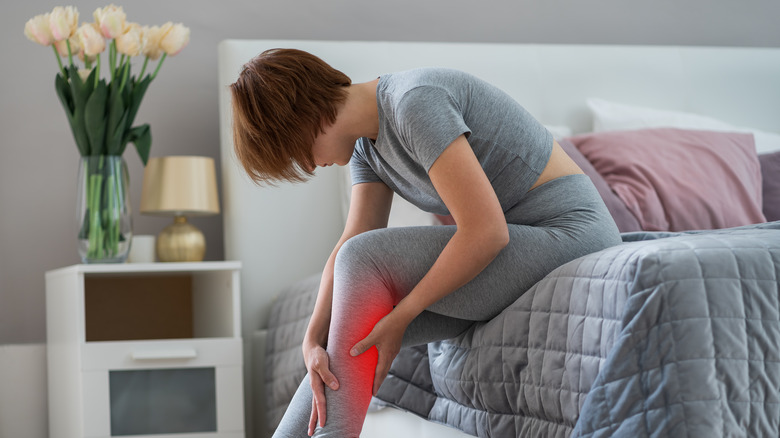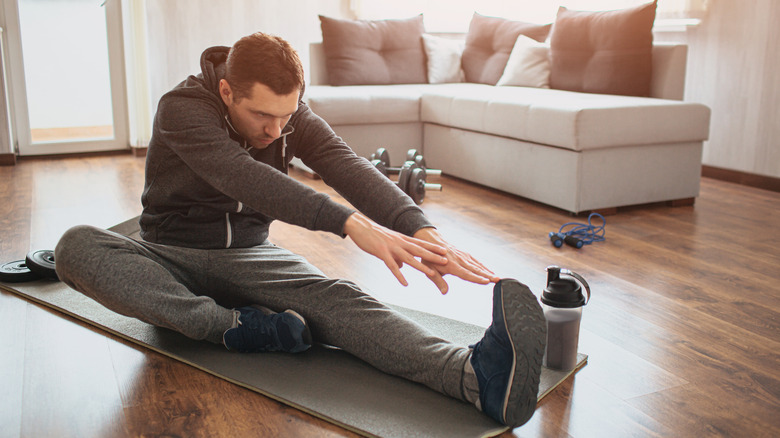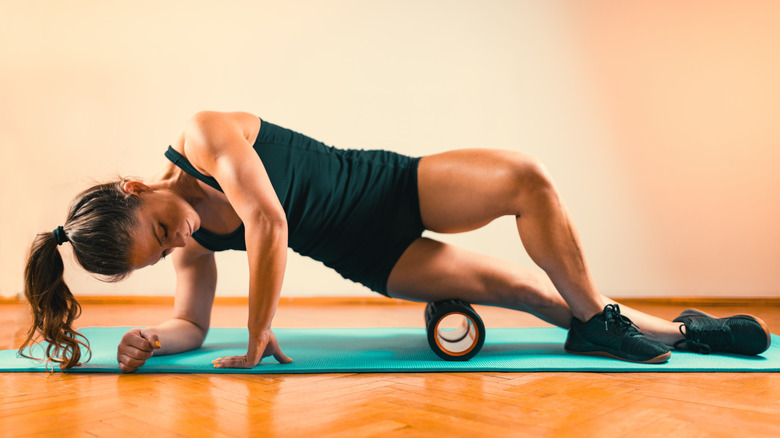This Is What You Can Do To Prevent Leg Cramps
Looking for the best ways to prevent leg cramps? First, try to determine what's causing them. For example, nocturnal leg cramps may be due to nerve problems, liver disease, or muscle fatigue, says the American Family Physician. Sometimes, muscle spasms and cramps occur because of dehydration, mineral deficiencies, or overtraining, according to Scripps Health.
This problem is more likely to affect those who spend long hours on their feet, but it also occurs in office workers. "People who have long commutes or sedentary jobs often spend long periods with muscles locked in unnatural positions," internal medicine doctor Rio Dickens-Celestin tells Scripps Health. If that's your case, consider switching to an ergonomic workstation and taking regular breaks at work. A diet low in magnesium, calcium, potassium, and other electrolytes may cause leg cramps, too.
Simple remedies such as heat therapy, massage, and regular stretching can provide instant relief. In more severe cases, doctors may prescribe medications to reduce pain and inflammation. Here's what you can do to prevent leg cramps in the first place.
Tweak your workout routine
Harvard Medical School explains that not warming up your muscles properly before exercise can lead to cramps. "A warm-up quite literally warms the body up and raises your core temperature slightly in order to make the muscles, ligaments, tendons, joints, etc. more mobile and flexible in order to improve performance and prevent injury," health and fitness expert Jillian Michaels tells Byrdie. This practice also helps increase blood and oxygen flow to your muscles, allowing for a more efficient workout.
Ideally, start with dynamic stretches targeting the muscles you want to train. For example, if you're having a leg workout, add a few sets of lunges or jumping jacks to your warm-up routine. Hip rotations, leg swings, and mountain climbers will do the trick, too. "The goal is to perform [a] relaxed, easy activity," points out Michaels.
If you're new to exercise, start slowly and focus on building up your fitness. Doing too much too soon can result in overtraining and injuries, warns Scripps Health. To stay on the safe side, listen to your body and forget the old saying, "No pain, no gain."
Supercharge your diet
As previously noted, leg cramps can also be due to low levels of electrolytes and minerals. In one study, researchers asked 10 men to run downhill in the heat for 40 to 60 minutes and then drink either spring water or an electrolyte beverage. The latter decreased their odds of experiencing muscle cramps after training, reports the Journal of the International Society of Sports Nutrition.
The human body needs optimal levels of calcium, potassium, sodium, and other minerals to function properly. These nutrients can become depleted during exercise (via the Journal of Sports Sciences). Prolonged or strict dieting, fasting, and dehydration may cause electrolyte imbalances, too. That's why Harvard Medical School and other organizations recommend eating foods rich in potassium and magnesium.
Bananas, dried beans and peas, fish, milk, and spinach are among the best sources of potassium (per University of Michigan). Magnesium occurs naturally in pumpkin seeds, cashews, dark chocolate, and other whole foods, notes the Cleveland Clinic. You may also drink electrolyte beverages during or after exercise to prevent muscle cramps. Note, though, that these products may contain sugar and sweeteners, so remember to check the nutrition labels.
Keep your muscles strong and flexible
One of the best things you can do to prevent leg cramps is to keep your muscles strong and flexible, physical therapist Matthew Hyland told Everyday Health. "Once we pass into the fourth decade of life, it is critical we play an active role in stretching and strengthening our bodies to maintain appropriate, maximal health," he explains.
Make sure your workout includes both stretching and strengthening exercises, followed by foam rolling and other recovery techniques. For example, family physician Matthew Goldman recommends stretching your calves for five minutes, three times a day (via the Cleveland Clinic). Position yourself about 3 feet away from a wall and lean forward so you can touch it with your hands. Keep your arms straight and your feet flat. If you do it right, you should feel a stretch in your calf muscles. Hold this position for five counts, relax your body, and repeat.
Dr. Goldman also suggests doing some light exercises and stretches at bedtime. A short walk or bike ride, or even just gentle leg stretches, are more than enough. As mentioned above, you may also use a foam roller for self-massage. This technique may help prevent muscle cramps and improve circulation, leading to faster recovery (per Marathon Training Academy).




